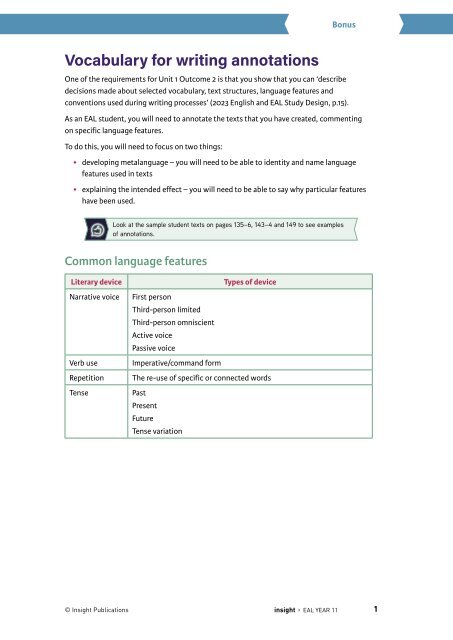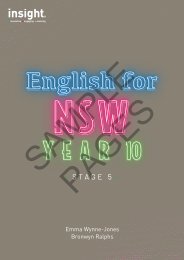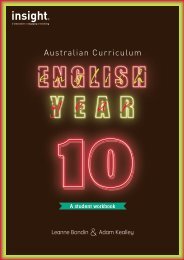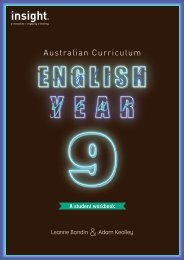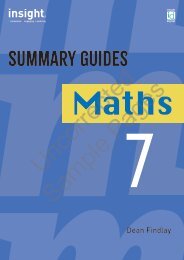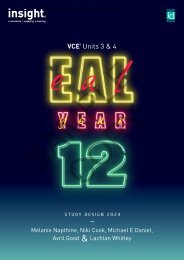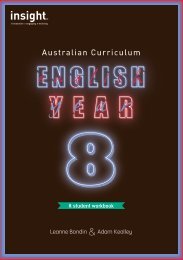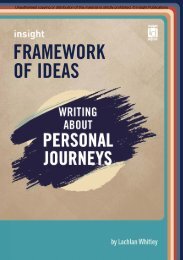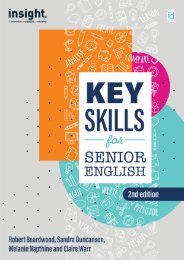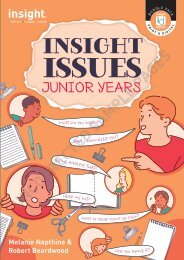FINAL\Page158_EALYear11_Vocabulary_for_writing_annotations
Create successful ePaper yourself
Turn your PDF publications into a flip-book with our unique Google optimized e-Paper software.
Bonus<br />
<strong>Vocabulary</strong> <strong>for</strong> <strong>writing</strong> <strong>annotations</strong><br />
One of the requirements <strong>for</strong> Unit 1 Outcome 2 is that you show that you can ‘describe<br />
decisions made about selected vocabulary, text structures, language features and<br />
conventions used during <strong>writing</strong> processes’ (2023 English and EAL Study Design, p.15).<br />
As an EAL student, you will need to annotate the texts that you have created, commenting<br />
on specific language features.<br />
To do this, you will need to focus on two things:<br />
• developing metalanguage – you will need to be able to identity and name language<br />
features used in texts<br />
• explaining the intended effect – you will need to be able to say why particular features<br />
have been used.<br />
Look at the sample student texts on pages 135–6, 143–4 and 149 to see examples<br />
of <strong>annotations</strong>.<br />
Common language features<br />
Literary device<br />
Narrative voice<br />
Verb use<br />
Repetition<br />
Tense<br />
Types of device<br />
First person<br />
Third-person limited<br />
Third-person omniscient<br />
Active voice<br />
Passive voice<br />
Imperative/command <strong>for</strong>m<br />
The re-use of specific or connected words<br />
Past<br />
Present<br />
Future<br />
Tense variation<br />
© Insight Publications 1<br />
insight EAL YEAR 11
Bonus<br />
Literary device<br />
Imagery<br />
Types of device<br />
Note the difference between figurative and literal imagery. Figurative<br />
imagery tends to play with meaning, and does not describe something<br />
real. For example, ‘You are my rock’ doesn’t mean that the person is<br />
literally a rock, it means that they are reliable.<br />
Literal imagery describes exactly what is there. For example, ‘The wind<br />
whistled through the branches of the gnarled oak tree, as the leaves<br />
cascaded to the ground.’ This is a highly descriptive sentence, but<br />
everything described is actually in the image.<br />
Figurative language<br />
Metaphor<br />
Simile<br />
Onomatopoeia<br />
Personification<br />
Hyperbole<br />
Oxymoron<br />
Word choice<br />
Structuring<br />
strategies<br />
Literal language<br />
Visual imagery (sight)<br />
Auditory imagery (hearing)<br />
Olfactory imagery (smell)<br />
Gustatory imagery (taste)<br />
Tactile imagery (touch)<br />
Connotations<br />
Colloquialisms<br />
Slang<br />
Jargon<br />
Formal language<br />
Juxtaposition<br />
Foreshadowing<br />
Sentence length<br />
Punctuation<br />
2 insight EAL YEAR 11<br />
© Insight Publications
Bonus<br />
Verbs <strong>for</strong> explaining effects<br />
Extends<br />
Features<br />
Includes<br />
Verbs to refer to<br />
language<br />
Incorporates<br />
Repeats<br />
Uses<br />
Utilises<br />
Verbs to illustrate connection<br />
to the mentor text<br />
Adapts<br />
Anchors<br />
Borrows<br />
Builds on<br />
Connects to<br />
Draws on<br />
Links<br />
Mimics<br />
Reflects<br />
Reworks<br />
Conveys<br />
Depicts<br />
Verbs to introduce<br />
explanation<br />
Emphasises<br />
Evokes<br />
Explores<br />
Illustrates<br />
Implies<br />
Indicates<br />
Relays<br />
Shows<br />
Suggests<br />
Putting it all together<br />
When completing your <strong>annotations</strong>, refer to a specific language example or textual feature,<br />
and explain how it works and why you have included it. Remember:<br />
WHAT HOW WHY<br />
Consider the following example:<br />
I emerge from the water, unsteady<br />
but invigorated. My skin is purple and<br />
puckered, reminiscent of the turkey<br />
waiting in the kitchen. I stagger up the<br />
beach to a warm towel, a warm hug<br />
and a warm Thermos.<br />
Through the use of literal and figurative<br />
imagery, I have created a vivid picture of<br />
the character’s appearance by describing<br />
how they look and providing a connecting<br />
image (the turkey). This conveys the<br />
physical impact of the swim on the<br />
character, while also rein<strong>for</strong>cing the<br />
overall Christmas setting of the piece.<br />
© Insight Publications 3<br />
insight EAL YEAR 11


